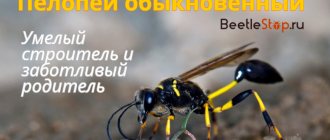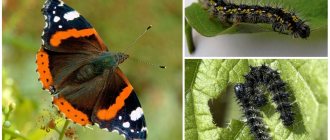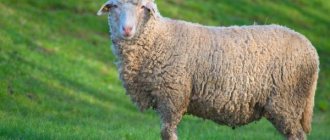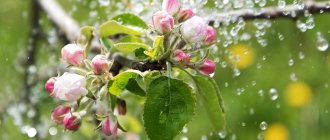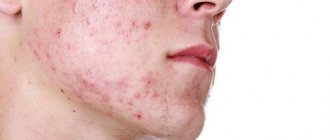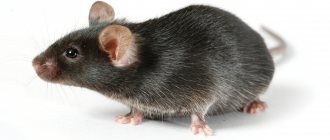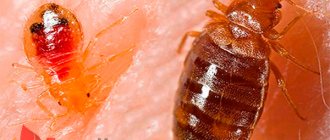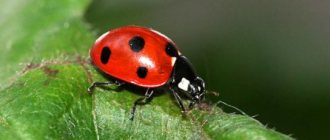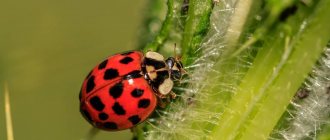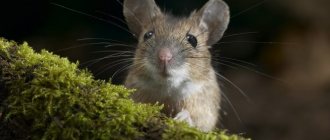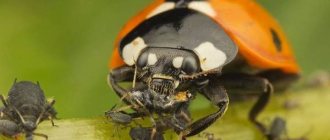Sandy ammophila
In spring and summer, not only hoverflies, bumblebees, and bees fly to flowering plants, but also butterflies, beetles, and wasps.
Ammophila is a slender wasp with a narrow waist and an oblong abdomen, surrounded by a red belt. She hunts caterpillars of various cutworms living in the ground. But it is not the wasp itself that feeds on caterpillars, but its offspring (adult ammophila feeds on plant foods).
Before hunting, the ammophila digs a hole in the ground about 6 centimeters deep with an expanding chamber at the end. At the same time, she digs slowly, slowly; Its front legs, as always, serve as rakes, its jaws as shovels. Now the mink is ready, and you need a small flat pebble, slightly larger than the hole of the mink. Having found a pebble, the wasp carries it in its jaws and covers the hole with it. Now she can go hunting.
Having discovered a caterpillar, the ammophila first of all strikes it with a sting from below (between the head and the first segment of the chest). Having rested, she injects with a sting from below into each joint.
The caterpillar becomes lethargic, “sleeping”, and does not resist the enemy. And the ammophila delivers the prey to its place, to the burrow. Now the caterpillar will serve as living “canned food” for wasp larvae.
In my diary there is a description (dated June 17, 1968, Kapsukas) of observations of how the sand ammophila coped with delivering prey to the burrow. She dug a mink in a neighboring yard near a wooden house, and found a cutworm caterpillar in the garden, about 26 meters from the mink. At first she tried to take off with a paralyzed caterpillar, but it turned out to be beyond her strength. Then she began to drag her burden. The path was difficult: the terrain (potato field) was uneven, beds, potato stems and other plants were in the way. The wasp would leave its prey for a while, look for a more comfortable path, and then get back to work. At times the ammophila felt her load, as if she wanted to make sure that this was exactly her game.
In such observations, it is striking that the behavior of the wasp resembles the expedient actions of a rational being. She accurately chose the right direction and, through complex and difficult terrain for her, in 15 minutes, she finally delivered her load to the place. Amazingly, she found the location of the hole.
The wasp placed its prey at the hole, pulled back the lid and looked inside to see if everything was in order. Then, backing away, she dragged the caterpillar into the hole. There she laid an egg on a caterpillar, climbed to the surface, blocked the entrance with sand and pebbles, leveled the surface so that now the burrow site could no longer be found, and flew away.
Observations on the life of a bee
The honey bee is one of the most interesting and accessible objects for simple observations.
When starting to observe the honey bee, it is advisable to establish when in a given area its years begin in the spring and when they end in the fall. At what time does the honey bee’s working day begin and how long does it last (in May, June or July)? What plants do bees visit most often in May, June, July, August?
In the spring, in a flowering garden it is convenient to observe and monitor the work of bees, especially on apple trees, pears, plums and other trees and shrubs. Watch how a bee collects pollen. Examine the bee's hind legs through a magnifying glass.
Observe in the apiary what the bees do at the hive, at the entrance after returning with a burden (nectar and pollen). Try to establish in which direction (during observations) the bees fly to collect the burden. Write down your comments and illustrate them with drawings or photographs.
Giant crayfish arachnids
Insects
- Virtuoso violinists. Grasshoppers
- The most formidable enemy of farmers. Locust
- Flying caterpillars
- Butterfly flights
- Day butterflies
- Alien from Colorado. Colorado beetle
- Seven-spotted ladybird
- Orderly beetles
- The enemies of our enemies are our friends. Ground beetles
- Tireless workers. bumblebees
- Sandy ammophila
- Red forest ant
- Nikolai Nikolaevich Plavilshchikov
Ways to deal with stinging aggressors
Wasps living in the ground can be destroyed by mechanical means or chemicals.
Insecticides
Modern chemicals can get rid of any insects. Enteric insecticides can be poured into the nest or mixed with bait. In the first case, you need to prepare the solution according to the instructions and pour it into the tap hole. The top of the nest is closed with a weight that prevents the wasps from flying out. The product in powder or granules can be scattered at the entrance. Insects will catch it on their paws and carry it inside, poisoning the larvae.
Making poisonous baits is a simple and safe way to combat ground wasps. The insecticide is mixed into sweet syrup or liquid honey. The container with the bait is left near the hole. Insects will not pass by the treat. With food, the poison enters the body of adults, and sticky drops from the paws will poison the larvae. Boric acid is suitable as a toxin. As the bait is eaten, syrup with insecticide is added. After one or two weeks, all the inhabitants of the nest will be dead. The following drugs are used:
- Karbofos - the product is sold in the form of powder and concentrate. Due to its pungent odor, it should not be used for traps.
- Aktara is a universal insecticide against harmful insects. The granules can be scattered on the ground, and the powder can be used for bait.
- Moskitol - thanks to the aerosol form, you do not need to go close to the nest. The spray from the can has a range of 6 m. The poisons cypermethrin and bioallethrin instantly paralyze insects.;
- Gett - a solution of the drug leads to disruption of the nervous activity of wasps. The product has a long shelf life.
Methods of controlling ground wasps using insecticides are safe and effective. But you should be careful around the nest.
Burnout
Fire is a formidable ally in the fight against insects. Burning a nest is a simple and effective method. Paper honeycombs burn well, especially after pouring kerosene or gasoline. Several liters of flammable liquid will be required. A small path is made near the hole for ignition. After bringing a match, it is better to run away, as there may be a small explosion and a burst of flame. The method is not recommended if there are flammable buildings nearby.
Advice. Before you begin extermination, monitor the wasps and find out where the entrances to the nest are located. They need to be plugged, leaving only the main entrance.
Boiling water
One of the mechanical ways to destroy stinging insects is to pour boiling water over their home. The method is absolutely inexpensive, but is inferior in efficiency to the use of chemicals. It will be an alternative to burning. Hot water will need about 20 liters. Boiling water is quickly poured into the hole, which is closed with a stone. The disadvantage of this method is that not all insects will die after contact with water. The procedure will have to be repeated. You should work with boiling water carefully to avoid getting burned.
Larra anathema wasp
These wasps are highly valued by gardeners, as they are assistants in the destruction of mole crickets. Larra anathema is a solitary wasp. It has a black color. When Larra Anathema finds a mole cricket, she drives it to the surface and paralyzes it there with three targeted sting strikes in certain places on the body. After this, the wasp lays an egg under the front leg of the victim.
Larra anathema wasp laying an egg as a victim.
After 5 minutes, the paralysis passes, and the mole cricket climbs underground, continuing to lead its usual lifestyle. The larva of a burrowing wasp emerges from the egg and develops in about 30 days, during which it molts 5 times. All this time, the larva lives as an external parasite on the body of the mole cricket. The mole cricket dies shortly before the larva pupates.
Philanthus - bee wolf
Representatives of this species are distinguished by large heads with powerful jaws. Bee wolves are quite strong and large. The wasp's chest is black, there are 1-3 white stripes on its back, and its belly is bright yellow.
The bee wolf is a killer of honey bees.
Philantes were called bee wolves because they kill honey bees. When a bee collects nectar, the philanthus suddenly rushes at it, wraps its paws around it and stings it in the neck, after which the bee dies. After this, the bee wolf makes rhythmic movements with its paws and squeezes honey out of the bee's crop, and then licks it off with its tongue. When the bee wolf completely devastates the bee, he takes it into the hole, in which hungry offspring are already waiting.
Bee wolves cause serious damage to beekeepers when they settle close to hives, since the bees do not leave the hive and stop producing honey. In such a situation, the queen bee does not lay eggs, and the colony gradually weakens.
Appearance of a burrowing wasp
The sizes of burrowing wasps vary: the body length of different species can reach 2-55 millimeters.
The pronotum in the upper part looks like a roller, which is a distinctive feature of this group of wasps.
Because burrowing wasps dig into the ground, they have hard, ridge-like scutes on their front legs that act like a shovel when pushing back the soil. But it is worth noting that not all wasps of this group settle in the ground; some representatives prefer wood or plant stems.
In many burrowing wasps, the apical segment looks like a flat platform, since wasps use such segments to pull out soil and level the walls of passages.
Burrowing wasp (Crabronidae).
How to Avoid a Bite
A bee, its bite and sting.
To avoid a bite and save the life of a useful creature, you need to follow certain rules:
You should not run, make sudden movements, or wave your arms at the sight of a striped creature. You need to stop, freeze, wait for the insect to fly away. Even if it lands on a person’s skin, it will not bite unless there is a danger to its own life. When going outdoors in the spring, you should not wear bright clothes or walk barefoot on the grass.
Such actions provoke bees, which are in constant search of pollen and flowers. You should not use sweet-smelling perfumes. Be careful when picking berries and eating fruits on the street.
To avoid trouble, it is worth studying the differences between a bee and a wasp and their bites. The latter are distinguished by aggressive behavior, capable of biting several times in one minute. The body of the wasp is oblong, while that of the bee is round. The latter tries to quickly move away from the person; the wasp can become annoying, circling over the head and body for several minutes. After the bite of any of these insects, swelling, redness, pain, and burning occur. The main difference is that a bee leaves a sting, a wasp does not. Bee venom is more dangerous because the capsule remains inside the person, the wasp releases only a small portion of the venom.
Sources
- https://KlopVred.ru/osy-i-shershni/kto-ostavlyaet-zhalo-osa-ili-pchela/
- https://GdeKlop.ru/osy-i-pchely/smert-posle-ukusa/
- https://MedVoBlago.ru/produkty-pchelovodstva/ukus-pchely
- https://stoptarakan.ru/ukusy/kto-umiraet-osa-ili-pchela-posle-ukusa.html
- https://ObOtravlenii.ru/ukusy-nasekomyh-i-zhivotnyh/pochemu-umiraet-pchela-posle-ukusa.html
- https://7ogorod.ru/prochee/ostavlaet-li-osa-zalo-pri-ukuse.html
- https://kursi-floristiki.ru/osy/pchela-umiraet-posle-ukusa.html
- https://apest.ru/nasekomye/pchely/pochemy-pchela-umiraet-posle-ukusa/
Weaknesses of OS
Despite their high defensive ability and propensity for public defense, wasps have weaknesses. They have many enemies. The main ones are parasitic neighbors. Who are these enemies?
- Wasp hives are home to a large number of mites, various beetles, and even other types of parasitic wasps. Their food base is larvae. Due to the fact that these parasites are small in size, have excellent camouflage and a sting, they skillfully protect themselves from working individuals.
- Although the flight speed of wasps is not so low, it is far from a record for the class of insects. It does not make it possible to avoid the fate of becoming a delicacy for wild animals - bears, wolverines, hedgehogs. Moreover, for them wasp stings are not an obstacle to eating.
- Wasps become a favorite treat for many birds. Buzzards are especially distinguished in this. They track their prey over several hundred meters and catch it in flight.
Danger to people
Being close to predatory insects can be beneficial. Wasps that have settled on the site will help with the destruction of pests. Over the summer they will catch hundreds of flies, caterpillars, and butterflies for their offspring. All the positives are outweighed by the harm done in a few cases. Why are ground wasps dangerous?
- If there are allergy sufferers in the family, a bite can provoke a dangerous immune reaction in the body.
- The proximity of insects is undesirable for small children.
- The nest is located in the garden bed and interferes with harvesting.
- The proximity of wasps next to the apiary is unacceptable. Predators will kill bees.
Attention. Wasp venom can paralyze or kill invertebrates. The bite causes significant pain to humans and domestic animals. The danger threatens only people with individual intolerance to insect toxins.
Literature
- Kazenas V. L. Burrowing wasps of Central Asia and Kazakhstan.
Determinant . // Science, , 170 pp. - Kazenas V.L. Burrowing wasps (Hymenoptera, Sphecidae) of Southeast Kazakhstan
// Tr. VEO, 1972, pp. 93-533. - Kazenas V. L.
Fauna and biology of burrowing wasps (Hymenoptera, Sphecidae) of Kazakhstan and Central Asia. - Almaty: KazgosINTI, 2001. - 334 p. — ISBN 9965-466-31-9. - Nemkov P. G., Kazenas V. L., Budris E. R., Antropov A. V. 1995. Sem.
Sphecidae - Burrowing wasps // Key to insects of the Russian Far East. T. IV. Reticuloptera, Scorpioptera, Hymenoptera. Part 1 / under general ed. P. A. Lera. - St. Petersburg: Nauka, 1995. - pp. 368–480. — 606 p. — 3150 copies. — ISBN 5-02-025944-6. - Pulavsky V.V. 1978. Sem.
Sphecidae - Burrowing wasps // Key to insects of the European part of the USSR. T. III. Hymenoptera. First part // Suborder Apocrita - Stalk-bellied (Arnoldi K.V. et al.) / under the general. ed. G. S. Medvedeva. - L.: Nauka, 1978. - P. 173-279. — 584 p. — (Key guides to the fauna of the USSR, published by the Zoological Institute of the USSR Academy of Sciences; issue 119). — 3500 copies.
- Bitsch J., Y. Barbier, S. F. Gayubo, K. Schmidt & M. Ohl (1997) Hyménoptères Sphecidae d´Europe occidentale
. Vol. 2. 1-429, Paris. - Blösch, M. (2000) Die Grabwespen Deutschlands
. 1-480, Goecke & Evers, Keltern. - Lomholdt, O. (1984) The Sphecidae (Hymenoptera) of Fennoscandia and Denmark.
Fauna Ent.Scan. 4, part 1: 1-224.
Content
- 1 Biology
- 2 Characteristics
- 3 Distribution
- 4 Phylogeny 4.1 Phylogeny (2018)
- 5.1 Subfamily Astatinae
Reproduction in nature
Burrowing wasps are insects that are very sensitive to their offspring. They prepare food for future use for their larvae and even build houses for the younger generation. The food for wasp larvae is mainly butterflies, caterpillars, flies, aphids, and spiders. Certain species of wasps choose “their” insects as prey. These wasps do not live in groups; we can say that they are loners, so they take care of their offspring on their own. After the female wasp prepares a home for herself in the ground, she, like a thrifty housewife, fills the nest with food and only then lays eggs. The earthen burrow is closed at the top for protection. Some types of females check the nest with eggs every day in order to provide the larvae with fresh food. If there are several nests, then the burrowing wasp watches all of them.
Benefits and harms
Burrowing wasps are mostly beneficial insects. They destroy mole crickets and other burrowing pests, which they use to feed the larvae.
And the bee wolf causes harm . Beekeepers with large apiaries are forced to constantly fight the invasion of such insects, which are the main pests of their honey bees.
Types of burrowing wasps
This is a fairly large group of insectivores, numbering more than ten thousand species. The most common ones are:
- The Larra wasp is anathema. This species is especially valued by gardeners and gardeners because its representatives exterminate pests, including mole crickets. This burrowing wasp is a solitary wasp, feeds on nectar, loves warmth, and can be recognized by its black color. While hunting for a mole cricket, she strikes a blow that paralyzes the insect. The wasp then lays an egg in the victim's body. After the effects of the poison wear off, the mole cricket climbs deep underground. It is there that the wasp larva develops best, simultaneously parasitizing the pest. The mole cricket dies shortly before the formation of a pupa inside it occurs.
- Sandy ammophila. It has a thin and long body, color – black with a red belly. Sandy ammophila is considered a large representative of burrowing wasps - its length can reach four centimeters. This burrowing wasp feeds its offspring with caterpillars that live in the ground. First, the sand ammophila hunts a prey that is several times larger than the wasp, then paralyzes it and drags it into its nest. Lays eggs directly on the caterpillar so that the larva can feed on it.
- Bee wolf, philant. This species of burrowing wasps is quite large, with a large head, developed jaws and a powerful body. The color of the philanthus is black and yellow, with several white stripes on the back. The name determines the way of life of the wasp - it hunts honey bees. After the victim is caught, the philanthus fatally stings it, eats the honey, and takes the body of the killed bee into the nest, in which it feeds its offspring. The bee wolf causes significant damage to beekeepers.
- Common minnow. This burrowing wasp is black in color, with whitish spots and a red belly. The food for the common minnow is nectar and insects, such as grasshoppers and crickets. Usually the victims of these burrowing wasps are much larger than themselves. Having grappled in a fight with an insect much larger than itself, the minnow fights to the last and, as a rule, emerges victorious. After the sandworm inflicts fatal blows on the victim with its sting, even a very large grasshopper gives up the ghost.
- There are also road wasps that lay eggs in the bodies of spiders.
Nutrition
The sand wasp is a harmless and even useful creature. It feeds on plant nectar, juices of ripe fruits, vegetables, and water. Spends the night among grass and trees, clinging with its paws and jaws to a blade of grass, a leaf, or a twig. Wakes up with the first rays of sunshine.
On a note!
Hunting for armyworm larvae brings significant benefits to humans, since caterpillars are serious pests of many agricultural crops. They even eat supplies in barns.
Wasp Ammophila
Ammophila, which translates to sand-loving wasp, is a familiar burrowing wasp that builds burrows in dry, barren soil. Ammophila is easily recognized by its long slender body, usually black, with a conspicuous red or orange-red patch at the end of its extremely narrow abdomen. This skilled digger uses two sets of tools: powerful, pointed mandibles, with which the wasp bites into the soil to loosen it, and front legs with peculiar brushes made of hard bristles, with which the wasp rakes away lumps of soil.
There are never any traces of excavation left around the nest. The wasp squeezes lumps of soil between the head and chest - so to speak, under the chin - and carries them to the side, flying ten centimeters away from the mine. Having dug a vertical shaft approximately the length of its body, the wasp makes a spacious chamber at the bottom, where it will place several caterpillars and its own offspring. Although this requires taking out a lot of soil and moving it aside, taking a few grains of sand each time, building a nest takes only about 45 minutes for the ammophila.
Then the female goes in search of prey, but before leaving, she closes the nest and masks the mouth of the burrow with lumps of earth, pebbles or twigs. Having caught a caterpillar, sometimes larger than itself, the wasp drags the prey to the nest, only in some places it manages to fly a little. Among the many nests, the female confidently finds hers, opens it and drags the prey into the chamber. She then lays a single egg on the caterpillar's body and seals the nest. This time, the wasp not only closes the entrance to the burrow, but also throws sand and gravel on it and levels the surface so that it is completely impossible to find the entrance.
The diligence and dexterity of the ammophila have long attracted the attention of naturalists, but only relatively recently two Dutch entomologists, who studied this wasp in detail, discovered one amazing feature of its behavior. They noticed that, having sealed a nest, the female can begin building the next one or open a nest built earlier
This in itself is unusual - most solitary wasps do not return to their sealed burrows. Researchers also learned that sometimes the female, on a second visit, only inspects the nest, and sometimes, having inspected it, flies away and returns to the nest, but with prey: she delivers a fresh supply of food for the larva, which has already eaten the first caterpillar. After replenishing its supplies, the wasp seals the nest and leaves it alone for several days. Meanwhile, she continues working on the third nest, inspects the second, and then returns to the first again, adds a few caterpillars to it and finally seals it. In this case, the ammophila not only blocks the entrance to the nest with pebbles, but also uses its head, like a hammer, to forcefully drive them into place. Sometimes she even grabs a pebble with her mandibles and rams the soil with it - one of two known cases of the use of “tools” by insects. Now the nest is tightly sealed, the female has done everything necessary for her firstborn - providing him with enough provisions for him to complete his larval stage and pupate in a protected burrow. Then the ammophila replenishes supplies in the second nest, finishes accumulating provisions in the third, and sometimes begins to build a fourth.
So, it turns out that this little wasp is simultaneously caring for at least three nests at different stages of development. She quickly finds each nest, although they are all camouflaged and surrounded by many of the same nests. She also knows when to visit which nest. After each visit, the wasp obviously remembers exactly what needs to be done: where to lay an egg, where to close up an unfinished hole, where to bring the next portion of caterpillars for the growing larva. Moreover, the wasp knows where to bring one caterpillar, where to bring several, and where to bring nothing. The information the wasp receives from a given nest is stored separately from the information it receives from other nests. The female usually visits the nest that is most in need of replenishment of food supplies; Apparently, she receives incentive from him to search for caterpillars. By immediately visiting another nest, she may receive a completely different stimulus there and yet will not forget either the location of the other nests or their needs.
Is it dangerous for humans?
Burrowing wasps are less poisonous and dangerous when compared to paper wasps. Ammophila bites people extremely rarely. This happens most often in cases of urgent need. Usually these insects prefer to hide unnoticed from human eyes. Ammophila does not transmit signs to other relatives, so there is no risk of an attack by a whole swarm.
She uses the sting for the purpose of self-defense when she is accidentally pressed on , stepped on or pressed against her. The ammophila will not be the first to attack or bite. The burrowing wasp does not form cocoon-shaped nests, so it has nothing to protect. And if a person accidentally steps on the place where the larva with the victim is hidden, then he will not be able to damage it, since it is located at a great depth.
After a bite, a standard allergic reaction develops.
It usually goes away on its own after first aid is provided to the victim.:
- Inspect the wound to identify the sting remaining in it. Usually it does not remain in the wound, because, unlike bees, it is firmly attached to the abdomen and there are no notches on it. It can remain on the victim only if the burrowing wasp was killed during the bite. If a sting is found, it is carefully removed.
- The wound is washed with any antiseptic (hydrogen peroxide, potassium permanganate solution, chlorhexidine solution). After treatment, apply an ice compress to the bitten area. This manipulation allows you to slow down the absorption of the toxic substance. Some try to squeeze out the poison, but this should absolutely not be done. Due to such actions, an infection can be introduced, which will provoke the development of an inflammatory reaction.
- If a person has been stung in nature and there are no disinfectants at hand, then you can use a plantain leaf. It is pre-washed with water, kneaded and applied to the wound. Dandelion leaf is also suitable for these purposes.
- The stung person is provided with complete peace of mind and is also given plenty of fluids to drink. Water or warm sweet tea will do.
- It is advisable to take antihistamines (Cetrin, Loratadine, Suprastin), which will prevent the development of an allergic reaction. You can also apply an ointment with antihistamine components locally.
The listed actions are appropriate if the bite is single. If the insects have made multiple bites, as well as if the neck, tongue or larynx are injured, then you should immediately call an ambulance. The same should be done if a wasp has bitten a baby. Children are at increased risk of developing a serious allergic reaction due to a weak immune system.
Most often, the burrowing wasp does not pose a danger to humans and is also useful for gardeners. This is a special species of Hymenoptera that occupies a special place in the ecosystem.
If a wasp bites
As statistics show, the peak of wasp stings occurs in the summer months of July and August, when there are many flowers everywhere, as well as a large number of ripe sweet fruits and berries.
Hover flies
Hoverflies, also known as syrphids, are a large family with about 6,000 species. Some of them look more like bees, others like wasps, and others like bumblebees. They live everywhere, with the exception of Antarctica, desert areas and tundra. They got their name because of the characteristic sound made by their wings.
Syrphid larvae look like small leeches. They are distinguished by a wrinkled body of yellow or greenish color. They have no legs and are not particularly mobile. They feed on aphids, insect eggs, and spider mites, which bring considerable benefits to agricultural land. A caring mother syrphid lays eggs directly in the aphid habitat.
However, not all hoverfly larvae prefer to see garden pests on their menu. The food preferences of all species are very diverse. Some of them are purely vegetarians and eat only plant tissue. The most exotic representatives process manure or wood.
Habitat
All wasps are divided into two groups - social and solitary. Their habitat differs depending on their lifestyle.
Social individuals live in nests and hives. They choose their habitat depending on how much material there is nearby for building a home. Insects also try to settle in places where there is a lot of food.
Solitary individuals, unlike social ones, do not have a permanent place of residence. They spend the night in the grass and on flowers. To stay on the plant, insects cling to it with their jaws or paws. At dawn, single birds fly to a new place.
Lifespan
Various representatives of the wasp family can live from a couple of months to several years. Species and external natural factors influence how long wasps live. Wasps are conventionally divided into solitary and social; their life spans are different.
Social ones live in a strict hierarchical system, like bees. Singles lead an isolated existence.
Uterus
The long-lived female among social wasps of all species lives for several years. All summer, the queen actively replenishes the population of the nest, continuously laying eggs. Towards the end of August, new, large cells for special offspring appear in the nest. From these cells young females and males hatch.
Before the onset of cold weather, they mate, after which the males die, and the future mothers of the family look for a place to winter. Females hide under bark, remnants of grass, and leaves. How many years the queen will live depends on a well-chosen location. Smart and lucky ones will survive 3-4 winters.
Working individual
Workers are the main population of a wasp hive, females who are not capable of reproduction. The working individual lives for about two months, the composition is constantly updated due to the continuous work of the uterus. By the end of summer, construction is no longer required; the worker wasps have completed their function. They restore order in their summer residence by eating larvae that have not yet been born.
After the act of cannibalism they set off on a journey. With the onset of the first frost, everyone dies. There are theoretical data according to which the queen of some species of the wasp family leaves the nest, dying along with the workers.
Males
In the tough wasp matriarchy, males are not particularly favored. They are born to fertilize females at the very end of summer; with cold weather, certain death awaits them. The lifespan of a male is about a month, with a maximum of 40 days. It all depends on the time of frost.
Rules for first aid for a bite
Timely assistance is divided into the following stages:
- Disinfecting hands with soap.
- Rinse the wound itself under slightly cold water to prevent dirt from getting inside.
- Disinfecting the bite site, for example, with hydrogen peroxide.
- Apply a compress in the form of a piece of cloth soaked in slightly cold water.
- Taking any antihistamine: Supradin, Zodak, Erius, taking into account contraindications and dosages specified in the instructions.
In addition to special medicinal products, lotions made from tea, onion or plantain are very effective for relieving swelling.
If several wasps attack at once, or if, after being bitten by one individual, the symptoms do not go away or intensify within several days, you should immediately consult a doctor. Even after apparent complete recovery, a visit to a local clinic is recommended.
